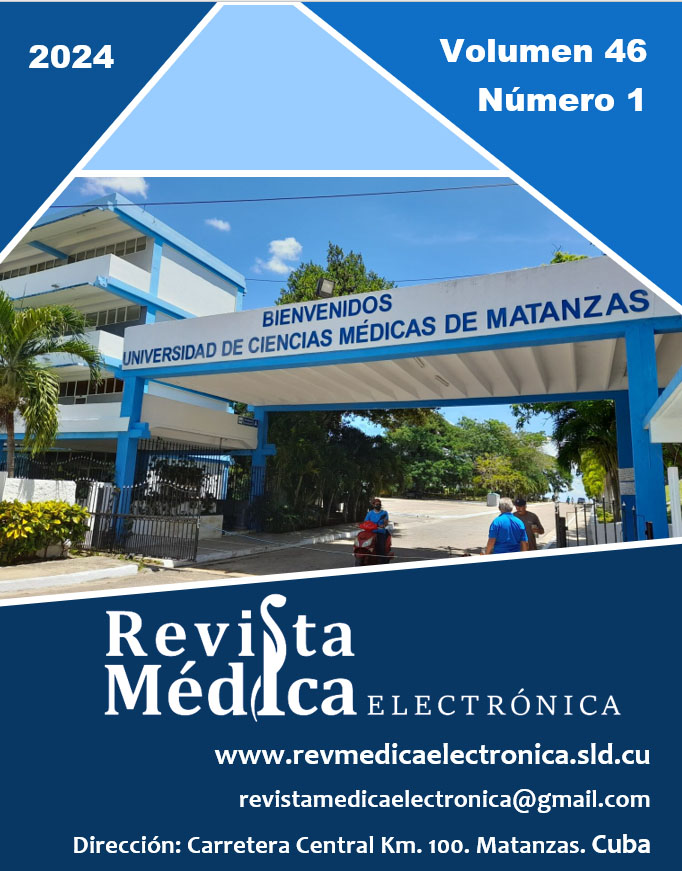Strategy for the promotion of healthy behaviors in the elderly
Keywords:
older person, healthy behaviors, lifestyle, promotion strategy, public healthAbstract
Introduction: Population aging is a global problem. Cuba is no stranger to this phenomenon, being the country in Latin America and the Caribbean with the oldest population. It is one of the greatest triumphs of the Cuban Revolution, but also one of its greatest challenges today.
Objective: To design a strategy to promote healthy behaviors in older adults.
Methods: The methodological design corresponds to a development study, whose product is a strategy for the promotion of healthy behaviors in the population studied, with an intersectoral approach that responds to the problems detected. At the author's convenience, a study group of 66 older adults, of both sexes, was taken.
Results: The initial diagnosis of health behaviors, the perception of well-being and quality of life of a group of older adults, allowed the design of the promotion strategy for the development of healthy health behaviors of the studied population, with an educational approach. It is structured in three stages: awareness, sensitization and exploratory diagnosis of the community. The instrumentation and evaluation of the strategy was carried out, all with their respective actions.
Conclusions: The initial diagnosis of health behaviors, the perception of well-being and quality of life of a group of older adults allowed designing the promotion strategy for the development of healthy health behaviors of the population studied with an educational approach.
Downloads
References
2. Departamento de Asuntos Económicos y Sociales, División de Población. World Population Prospectes 2019: Highlights [Internet]. San Francisco: Naciones Unidas; 2019 [citado 28/01/2022]. Disponible en: https://population.un.org/wpp/Publications/Files/WPP2019_Highlights
3. Organización Panamericana de la Salud. Carta de Ottawa para la promoción de la salud [Internet]. Ottawa: Organización Panamericana de la Salud; 1986 [citado 23/01/2022]. Disponible en: https://isg.org.ar/wp-content/uploads/2011/08/Carta-Ottawa.pdf
4. Pérez V, Lourdes O, Padilla M, et al. Las políticas públicas: una nueva mirada al envejecimiento poblacional en las condiciones actuales de Cuba. Universidad y Sociedad [Internet]. 2021 [citado 08/02/2022];13(3):512-24. Disponible en: http://scielo.sld.cu/scielo.php?script=sci_abstract&pid=S2218-36202021000300512
5. Ramos Monteagudo AM, Yordi García MJ. Envejecimiento demográfico en Cuba y los desafíos que presenta para el Estado. Medwave [Internet]. 2018 [citado 08/02/2022];18(4):7231. Disponible en: https://www.medwave.cl/enfoques/ensayo/7231.html?lang=en
6. García Velázquez M, Sánchez González T, Román Pérez R. Envejecimiento y estrategias de adaptación a los entornos urbanos desde la gerontología ambiental. Estud Demogr Urbanos. 2019;34(1):2-6.
7. Sanabria Ramos G, Pupo Ávila N, Pérez Parra S, et al. Seis décadas de avance y retos de la promoción de salud en Cuba. Rev Cubana Sal Púb [Internet]. 2018 [citado 28/01/2022];44(3). Disponible en: https://revsaludpublica.sld.cu/index.php/spu/article/view/1453
8. Marín Álvarez O. Todos se van: ¿Se puede evitar una crisis migratoria en Cuba? [Internet]. La Habana: Periodismo de Barrio; 2021 [citado 28/01/2022]. Disponible en: https://periodismodebarrio.org/2021/05/todos-se-van-se-puede-evitar-una-nueva-crisis-migratoria-en-cuba/
9. Santos Rodríguez M, Luis Rodríguez E, de Armas Urquiza R. Políticas públicas y envejecimiento en el Municipio Playa, La Habana, Cuba. Folletos Gerenciales [Internet]. 2020 [citado 12/07/2022];24(2):83-93. Disponible en: https://www.researchgate.net/publication/346400593
10. Vellas B, Guigoz Y, Garry PJ, et al. The Mini Nutritional Assessment (MNA) and its use in grading the nutritional state of elderly patients. Nutrition. 1999;15(2):116-22. DOI: 10.1016/s0899-9007(98)00171-3.
11. Millán Méndez IE. Evaluación de la capacidad y percepción de autocuidado del Adulto mayor en la comunidad. Rev Cubana Enfermer [Internet]. 2010 [citado 10/10/2019];26(4):202-34. Disponible en: http://scielo.sld.cu/scielo.php?script=sci_arttext&pid=S0864-03192010000400007&lng=es
12. Lawton MP. Escala de Philadelfhia [Internet]. Philadelphia: Philadelphia Geriatric Center; 1972 [citado 28/01/2022]. Disponible en: https://docero.tips/doc/escala-de-philadelphia-14yy26ppv1
13. Olaz Capitán A, Ortiz García P. La Técnica de Grupo Nominal. Una adaptación orientada hacia proyectos de intervención social [Internet]. Murcia: Editum; 2021 [citado 28/01/2022]. Disponible en: https://dialnet.unirioja.es/servlet/libro?codigo=831680
14. Herrera J, Lozano LC. Promoción y mantenimiento de la salud en el barrio: análisis de la Matriz DOFA de las intervenciones colectivas. Salud & Sociedad Uptc [Internet]. 2021 [citado 10/01/2022];6(1):1-16. Disponible en: https://revistas.uptc.edu.co/index.php/salud_sociedad/article/view/12001
15. Ministerio de Salud Pública. Principios de la ética médica. La Habana: Editorial Ciencias Médicas; 1983.
16. Asociación Médica Mundial. WMA Declaration of Helsinki. Ethical Principles for Medical Research Involving Human Subjects [Internet]. Ferney-Voltaire: Asociación Médica Mundial; 2022 [citado 10/01/2022]. Disponible en: https://www.wma.net/policies-post/wma-declaration-of-helsinki-ethical-principles-for-medical-research-involving-human-subjects/
17. Hernández Pérez R, Molina Borges M, Hernández Sanchez Y, et al. Efectividad de intervención educativa sobre estilos de vida en adultos mayores. Nueva Paz 2019-2020. QhaliKay [Internet]. 2021 [citado 10/01/2022];5(1). Disponible en: https://revistas.utm.edu.ec/index.php/QhaliKay/article/view/2943
Downloads
Published
How to Cite
Issue
Section
License
All content published in this journal is Open Access, distributed under the terms of the CC BY-NC 4.0 License.
It allows:
- Copy and redistribute published material in any medium or format.
- Adapt the content.
This will be done under the following terms:
- Attribute the authors' credits and indicate whether changes were made, in which case it must be in a reasonable way.
- Non-commercial use.
- Recognize the journal where it is published.
The copyrights of each article are maintained, without restrictions.






